“Living with Hiroshima” Keiko Murakami
Forward
“That Day’ to be passed on” by Keiko Murakami is the author-edited version of the series with the same title that appeared in the Jyoyo Newspaper July 25 to October 4, 2005.
Kim Jong Il in North Korea reigns over his country. The information available through media about him, his country and people under his dictatorship may be something unimaginable to the Japanese, especially to the younger generations, but Japan had been in an even harsher situation until it was defeated on August 15, 1945. Kim Jong Il is a “human” being who ranks top in North Korea, but the Emperor in Japan was a “divine” being, a living god in a human figure. A god is an absolute being. The Japanese people were obliged to live loyally to the Emperor and die bravely for him. They had no luxury to think how to live. Those who resisted had a tough time and some died in jail.
Today’s elementary school was called “national elementary school” in those days. It was an institution meant to nurture character that fits into the Imperial System. At each school there was a structure called “Hoanden” where a photo of the Emperor and Empress was placed. When we passed in front of it, we bowed deeply. Every morning we bowed in the direction of the Imperial Palace. When we came across soldiers in town, we stopped to salute.
On December 8, 1941, the Japanese Army made a surprise attack on Pearl Harbor. Afterwards, with the goal of liberating Asian countries, the invasions escalated into the war against the Allied Forces of the U.S.A, U.K., Soviet Union, China and others. The Japanese people were convinced of the victory of the Imperial Army. Therefore, we endured all the hardships and inconveniences in our daily lives, physically and psychologically, reciting slogans such as “We’ll do without until we win,” “A hundred million united as one to be an irresistible force,” “Divine wind will blow” or “ Savage America and England.”
Military City, Hiroshima
From the Meiji Era (1868-1912) on, Hiroshima bore an important role as a strategic position for the army. The central part of the city, including Hiroshima Castle, was a military base of the Imperial Army. My house was located near that area in Hakushima-kuken-cho.
During the war, volunteer work for the military was an obligation imposed on us. For example, the transportation means for the army senior officers in those days was horses, due partly to the scarcity of cars and partly to the gasoline shortage. Like food for people, feed for horses was also in short supply. So as volunteer service, school children visited house to house gathering used dried tea leaves or cut grass for horse feed. As soldiers rode around the city, there were lots of horse droppings on the roads. Children picked them up, gathered them at school, and then returned them to the Army. We heard that they were dried and used as fuel.
According to the news reports, the war was going in Japan’s favor. However, major cities throughout Japan were being destroyed by air raids. It was necessary to avoid non-combatants being victimized, so people were urged to evacuate to safer places. Those who had relatives or friends in rural areas moved out of urban cities. In the spring of 1945, schoolchildren’s evacuation was systematized. Third to sixth graders with no place to evacuate were taken in a group to rural temples, accompanied by teachers. I remained in the city for some family reasons. I had fewer and fewer old friends around me. There was a rumor spreading, “America wouldn’t bombard Hiroshima in fear of the strong army that is stationed there.” The senior Army officers’ families who had been affected by the bombardment in their hometowns were brought to the supposedly safer Hiroshima. Therefore, there were quite a few children still remaining in the city.
As the war turned critical, the Imperial Army gathered soldiers to Hiroshima from other places. The Army needed more facilities than available to accommodate them all. Part of our school buildings was given to the Army. Schoolchildren had classes in a small group at a temple nearby. Since education materials, notebooks, drawing papers, everything was in short supply, classes in those days were just practicing calligraphy on old newspapers, learning the myth of worshiping the Emperor or doing air-raid prevention drills. There were no summer holidays during the war. I later learned that this differed from place to place, but we had school in Hiroshima anyway. Perhaps, Hiroshima, as a military city, was special.
August 6 (Monday), 1945
I was in the third grade of Hakushima National Elementary School. That day, somehow I didn’t feel like going to the school and so said to my father, “I don’t want to go.” Usually a strict father, he listened to me and said, “Well then, you can stay home.” If I had gone to school, I… Everybody at the school, teachers and children died. One classmate who was on her way to school was exposed to the A-bombing on a bridge. She survived the bombing, but the left half of her body, having been seriously burned, was left rigid in the joints of her neck and arm. Rumor says there was one other classmate who survived the bombing, but none of us heard from him.
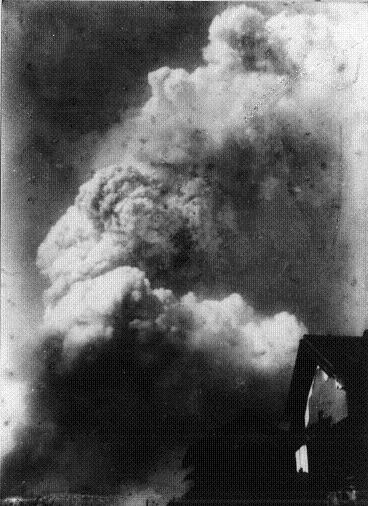
The Atomic Bomb was dropped at 8:15. A little before it, far in the sky, the sound of airplanes was heard. My father went outside in the garden and looked up and said, “This doesn’t sound like Japanese planes. It’s dangerous. Run to the shelter!” My brother, two years and ten months old, and I ran into the shelter that had been finished some days before in our house. A moment later, I felt a gigantic shock. That was the instant of the A-bombing. My father rushed toward us. Our house collapsed in a moment, but I grabbed my father’s waist and crawled out through debris–the fallen pillars, wall dirt and roof tiles.
We did not see Mother and called out loud for her. Then, the rubble under our feet moved and Mother appeared, holding my 57-day-old baby sister in her arms. Mother was injured with fragments of glass all over. Especially, large pieces of glass stuck on both of her eyelids and right cheek. Her right eyeball was out of its socket, dangling to her breast. My father scooped it with his cupped hand, but had no other way but to tear it off. To keep the blood from spouting, the glass fragments that had stuck everywhere–her left eyelid, cheeks, around her neck–were left as they were. My father also had serious injuries on the left half of his body, but he carried my mother with his right arm, leaving my younger brother and sister with me.
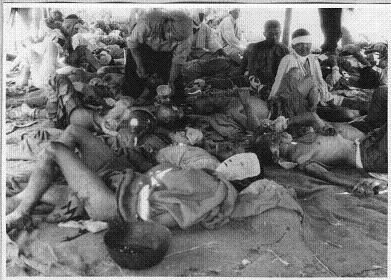
We thought that our house of all other houses had been targeted, so we went to our neighbors for help. But the houses of the next door neighbor and two doors away were also broken. Because of the dusty smoke, there was little visibility. We tried house after house walking about 300 meters and reached the dry riverbed. Since we acted swiftly, we managed to lay my mother in the shade of a little shrub. Before I noticed, many injured people had gathered around us. Some burned and injured soldiers were cursing the “enemy” like mad men, brandishing their swords. However, they collapsed one after another. The narrow riverbed was not spacious enough for all those evacuees, and before long a heap of the dead formed as the people mounted over the others.
My father, a civic officer, was the Chief of the Volunteer Service Corps Bureau. Since his duty was to lead evacuees or rescue people in case of emergency, he was eager to go on duty as soon as possible. But in order to do so, he needed to take care of his family first. I was entrusted to look after my mother and brother.
My father thought that my baby sister had already died, since she was bloody with the splashed blood from her mother. So, he was going to bury her temporarily there, intending to come back to dig the grave up later. He dug a hole. He felt it too pitiful to bury the blood-covered baby as it was, so he cleaned her body casually in the river water. Then, she uttered a faint cry. “Ah, she is alive! I’m glad we didn’t bury her.” Our moments’ joy turned to a new problem for us to face; the baby needed milk, but our mother’s breast milk dried up because of the shock. We were at a loss. My father was conscious of his professional duty even in such a situation. A riot by a horde of the injured was not unthinkable, so my father, together with some soldiers in better shape, made the rounds trying to reassure those evacuees, “A rescue team will arrive soon. Stay calm, please.” He happened to find a woman among the victims, whose breast milk was dripping. He pleaded with her for her milk, “Would you please give your milk for my daughter?” The woman refused and said, “This milk is my baby’s who has just passed away. I cannot give it to anyone else.” My father, with his head touching the ground, pleaded and pleaded. Then, the people around spoke for his help, “The dead baby won’t come back to life. Give your milk to the surviving baby and save her life.” Thus, the woman was persuaded to give her breast milk to my sister.
We had eaten nothing since the morning. We plucked the vegetables planted in the dry riverbed such as cucumbers, tomatoes, pumpkins and eggplants. At one bite, all of my family spat it out immediately. There were people who fought for what we had thrown away and ate it, which drew a distinctive line on the fate of survivors. Eating food or drink that was exposed to radiation meant radioactive intake into their intestines. Such people either died or, even if they survived, lived with many difficulties including internal organ disorders. They were forced to live a hard life in a tragic situation during the post-war period.
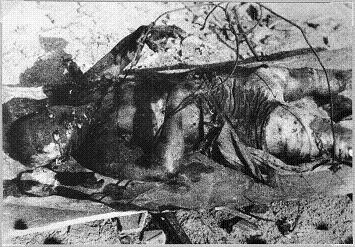
My father tried to engage himself in his duty, leaving the family there, but the area was a sea of fire. He intended to go to the City Office, crossing the river in front and making a detour. However, he realized it was impossible to swim across the river as the water ran fast. Besides, there were many bodies flowing and people crowded in the water to escape the heat. Having second thoughts, he engaged himself in keeping security all night in cooperation with soldiers, so that no unrest would be attempted.
Houses kept burning throughout the night, but by dawn the fires subsided. The A-bombed victims died one after another. Among those were the people who talked that woman into giving her breast milk to my sister.
A silent morning came. My father went back to the burned ruins of our house and dug out jars of pickled plums and shallots. Ushita-cho across from the river, an area tucked into the mountain, was spared the fire, so we decided to take shelter at our acquaintance’s house in the area. Upon leaving, my sister was given the woman’s breast milk one last time. We gave the pickled plums and shallots to the woman as a token of our appreciation. That was to initiate the anguish of my family, as our gift items had been contaminated by radiation.
After the war, when the immediate confusion in society somehow subsided, we began to look for the woman who gave milk to my sister through the NHK radio program, “Missing People” and the newspaper. However, we failed. If she had died because of those pickled plums and shallots, we would have made an irrevocable mistake.
Some days later, my grandfather and uncle came all the way from Yamagata-gun to look for us. It was decided that my brother and I would be put under our grandparents’ care. On the way to their house, I looked over the burned ruins of Hiroshima for the first time. Nothing familiar was in sight. All I saw was rubble. At a broken water pipe, people crowded for water mounting one on another. My uncle carried my brother on his back. My brother cried, “Mom, Dad!” When my uncle needed some rest, he took my brother off his back, but then my brother dashed backward trying to return. I chased after and soothed him, but I myself was feeling helpless and about to cry.
Summer in Hiroshima is hot and that summer was especially so, because the leveled land had nothing to make shade. We walked barefoot on the undistinguished roads filled with rubble that was heated by the blazing sun. Not knowingly, I stepped on a dead body that had been under the rubble. The feeling at that moment hasn’t faded to this date. Ever since, when summer comes around, the soles of my feet make me feel hot and uneasy.
In the A-bombed City
Hiroshima is a city built on a delta at the mouth of the Ota River, that runs through the Chugoku Mountains. The city is surrounded by mountains in the north, east and west, and the south faces Hiroshima Bay. Originally it was a small land, but Mr. Senda in the Meiji Era promoted to reclaim land. Hiroshima became a large land as it literally means. Mostly, the land is sandy. Many parts of the land are at sea level, so the city was often flooded when typhoons hit.
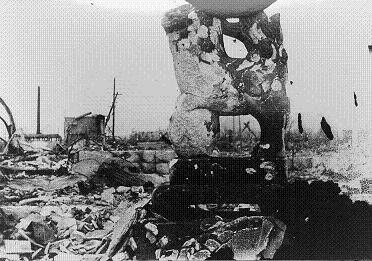
In October that year, strong typhoons hit the city twice, and washed away the sandy soil into the rivers. Many lives were also claimed by that natural disaster, which was tragic. However, because dirt and sand were newly brought in from other unaffected places to make up for the washed soil, the topsoil of Hiroshima became radiation-free. Scholars and medical staff were dispatched to Hiroshima from various places, including Tokyo University, to study about the A-bomb or to treat the victims. Rumor ran that some scholar said, “No plant will grow for the next 70 years on the A-bombed soil.” Trees and plants, however, began to sprout.
The next spring in 1946, A-bombed cherry trees revived. Petals danced around in the spring wind. When summer neared, oleanders bloomed. At the sight of the oleander flowers, many A-bomb survivors are said to have gained encouragement. Therefore, the oleander was designated as the flower symbol of Hiroshima City. Hiroshima was a burned ruin as far as the eye could see, dotted with shacks that began to rise one by one. Around them tomatoes and cucumbers were seen growing. However, I never liked red oleanders. Also, flaring red canna is something I won’t forget. Those red flowers symbolize the threatening blaze of that day.
Aftereffects of the A-bombing on Me
My grandfather took my brother and me to his place in Yamagata-gun, where he was living as a specialist of shrine carpentry. Therefore, he had only a small farmland, and the farmers nearby couldn’t afford to share food with others, as they themselves had accepted other victims to take care of.
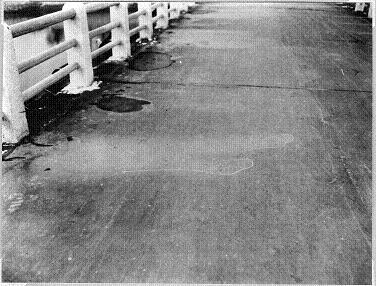
On August 15, Japan surrendered. Adults seemed to be at a loss at what they had believed in, but as a child I was happy, because we had no more enemy planes flying over and no more dashing into the air-raid shelter.
In October I had a high fever and began to suffer from bloody urine and stools. No information on the A-bombing had reached the local doctors in the rural area, so I was diagnosed as some bad infectious disease, and isolated in the shed. My brother banged on the door crying, “Sister, sister!” but I could do nothing. Since medicine was scarce in those days, I just stayed in bed. In about a month, those symptoms subsided, but smelly pus began to ooze from my ears. It came down to my throat overflowing my mouth. Again, there was no way to treat it, but only wipe it off.
In November, my family managed to rent a half-broken, survived house in Minami-machi, south of the city and started to live together. I began to see the doctor at the Red Cross Hospital, but medicine was in short supply at the hospital. A nurse murmured, “How I wish we had penicillin!” I told what I overheard to my father. A few days later, my father got three ampoules of penicillin on the black market. I remember I began to recover thanks to them.
After my brother and I left for Yamagata-gun, my parents and baby sister moved to the Relief Center for the A-bomb victims set up in the Fukuromachi National Elementary School. My mother had the pieces of glass removed by a doctor, who found out that her left eyeball was intact. It was fortunate that she was operated on by a specialist eye doctor and regained her eyesight. However, she had to stay mostly in bed as she was suffering from the malfunction of her internal organs as well as many injuries by glass fragments. All the house chores were on my shoulders, and I went to school with my sister on my back
Unending Ordeal
Ever since August 6, 1945, residual radiation has troubled people. Not just the people who were exposed to the A-bombing, but those who got involved in Hiroshima later in one way or another were also affected, either falling ill or dying. Among them were the people who tended the victims, who walked around the ruins, who were caught in the black rain, or those who did the corpse-clearing job. A rumor that you would be infected if you had physical contact with hibakusha, or survivor, spread wildly, and the hibakusha were discriminated against.
Many of those who came to live in Hiroshima after the war were either the people who had evacuated till the war ended or newcomers who had expected job opportunities in the city reconstructing process. They were busy looking after their own living, and had little sympathy with hibakusha. Also, many of the A-bombed had evacuated to remote or mountainous areas and remained there quite a while for recuperation, so it was fairly long before they could return to Hiroshima.
A-bombed women often had miscarriages, stillborn babies, or handicapped babies. For a long time, hibakusha were rejected or hesitant to get married, or chose not to have children. There were many known cases.
Twelve years had already passed before a hospital specializing in hibakusha treatment was finally built in 1957. It was established, not by the national government, by the effort of the Director of the Red Cross Hospital, Dr. Shigeto, who was instrumental to get the charity money from the New Year greeting postcards and constructed it on an vacant lot in the Red Cross Hospital grounds.
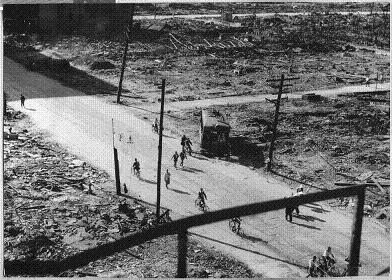
I got a job in that A-bomb Hospital in its initial stage. There, my job was to interview hibakusha and take notes of their A-bomb experiences as well as their complaints about health or life as a whole. Twelve long years had passed since Japan’s defeat, yet the A-bomb Hospital was crowded with those who had never visited any hospital before then due to their tight living. The interviewer, myself, was a hibakusha, but it was painful for me to take notes of their pathetic stories. Through my job, I came to think that my family was a relatively blessed one among other A-bombed families, although my mother was in critical condition lying in bed on the 2nd floor of the A-bomb Hospital.
One day I had a thorough examination. Although I had often been dizzy, I was not aware that I was ill. The result of the blood test was that both red and white blood corpuscles were fewer than half of the normal. I, a worker at the Hospital, became a designated hibakusha, which made me realize the sheer fact that I was an A-bomb survivor. The situation in those days drove me into the edge of despair, and I gave up and quit my job only after one and a half years.
Once a year ever since, I have a thorough examination, and the test result always shows that my blood is under the normal figure. However, I survive. Each individual is different–tall, short, thin, fat, or handicapped. It is true that I am allowed to live, whatever conditions there may be. So, I’d like to live in gratitude to my last day, thankful to God.
My Starting Point
In early summer two years after Japan’s defeat, my father took me to Tokyo. It was soon after the new Constitution was enacted. The trains ran with coal in those days, and smoke came into cars from the gaps between the window and its frame. I had a towel covering my nose. It took us nearly 24 hours to get to Tokyo. It was a trip with a few buns and food ration tickets for rice in my bag, because it was the time of food shortages.
The first night in Tokyo, we slept in the open together with homeless children in Ueno Park. The second night we stayed in the Red Cross Hospital accommodation facility near Shiba Park. On the last day of our several days in Tokyo, my father said to me at the moat side of Hanzomon, “I wanted you to know that Hiroshima was not the only place that was destroyed in the war. That’s why I took you to Tokyo. Japan’s Capital City, Tokyo, is exactly what you’re seeing now. During the war, there were people imprisoned, as they were against the war, saying it was wrong. But, I worked to defend the person who resides in this Imperial Palace surrounded by thick green. Forgive me, your sinful father. Look, Keiko! Isn’t the Imperial Palace distinctly beautiful in the devastated Tokyo, as if there had been no war? I am going to work hard in order to rebuild Hiroshima from now on, but it is your generation that has to be determined in their hearts and minds that Japan will never again engage in war. Don’t forget what you saw and experienced first hand in Hiroshima and Tokyo. You should not support fighting whatever reason there may be. Even if you lose your friends because of that and are left alone, I want you to go forward with courage. I’m expecting you to grow up that way.”
These words and the rare experience given by my father stayed inside me growing and changing colors, and became my indicator. However, it took me a long time before I felt ready to speak out about my own A-bomb experience. For one thing, I didn’t like the idea of telling my private story to people. The other was that I was scared to be asked questions, as there were lots of things I’d rather keep inside. Even things that mean nothing to others can give a great pain to me.
My teacher, Prof. Miyao Ohara, advised me to write what I had experienced, but I took no action. He translated Sankichi Toge’s poem, “Bring back Father, Bring back Mother” into English, bringing the poem worldwide acknowledgement.
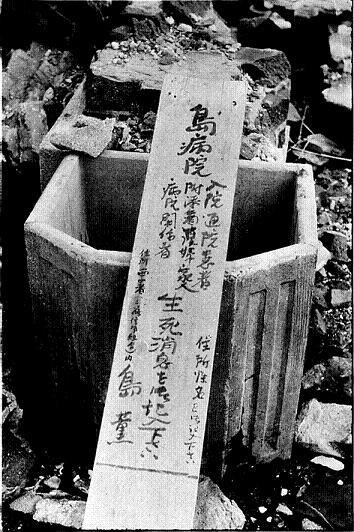
It was in 1981. It occurred to me to write an essay about my memory of the days at my grandparents’ home right after the A-bombing, and I applied for the first Hiroshima Civic Literary Works. It was kind of a casual decision out of my citizenship consciousness. My work, however, unexpectedly won the first place. Right after that, my mother died.
Though it was a new start for me to express ideas through writing, I was able to write only fiction, not my own experience. Yet, I wrote the thoughts and feelings of the A-bombed people to my heart’s content.
I remember it was perhaps 1984 when a pastor from Germany visited Hiroshima. I took charge to show him around. The same age as me, he began to speak while we were in the Peace Memorial Museum. “I had a very close friend during the war. One day, all of a sudden, his family disappeared. I asked my parents, ‘Why didn’t he say good-bye to me when they moved?’ My parents said nothing at that time. One day after the war ended, my parents told me that that family was Jewish.”
To hear that, I could barely stand with my knees trembling. I thought it a very true testimony of history. Although the pastor himself was not a Jew, what he said rattled something in my mind. If I say to someone, “I was exposed to the A-bombing in Hiroshima,” it might awaken his/her interests–“What is war?” “What is peace?” or “What are nuclear weapons?” Anti-nuke peace-seekers might increase. Then, I came to think that it was my responsibility to speak out on my A-bomb experience.
From that time on, I try not to miss a chance to speak whenever I can, but I never get accustomed to speaking. Although I keep regretting about something each time, I am short of words, or things like that, I’m trying my best to speak with my whole heart that I was affected by the first A-bombing in human history.
The current world situation is horrible. India and Pakistan are equipped with nuclear missiles, and the laborers at uranium mines throughout the world are exposed to radioactive contamination. The natives in the deserts and islands are also victimized by nuclear tests, but nobody is willing to compensate them for it. Some American soldiers who have been sent to the battlefields since the Gulf War are said to be suffering from the symptoms of radiation exposure. In the Gulf War area, Afghanistan and Iraq, of which America never loosens its tight grip, many cases affected by depleted uranium weapons are reported. America says the depleted uranium weapon is not a nuclear weapon, but the use of bullets made of depleted uranium means scattering radioactivity in the air. Today, weapons are so advanced that the radiation damages created are much worse than Hiroshima and Nagasaki.
In 2003, photographer Naomi Toyota’s photo exhibition on Iraq was held in Tsukuba City. Many of the pictures were of children. Their sad eyes synchronized with the image of myself; I must have looked just like them back in August, 1945. They must live with sad memories, just like me. Children aren’t supposed to have sad faces. It’s the role of world citizens, I think, to bring back their bright eyes that look to their hopeful future.
“Peace is nice,” “I hate war,” “No nukes”–It is easy to have those words only in your mind, but that doesn’t change anything. The important thing is to speak out and act whatever it is, however small it is. Over the past few years, we have seen big disasters inside and outside of Japan. In such circumstances, volunteer activities and spirit to care for the others gain strength. I believe that the realization of non-war and a peaceful world can be achieved by loving and caring for others, not just caring for ourselves. So, the time will come in the near future when this elderly woman won’t need to say anymore. I am going to live with hope.